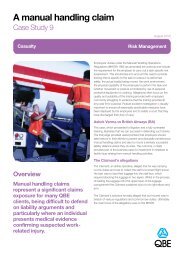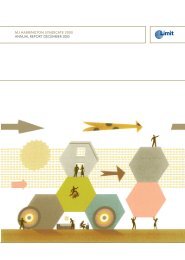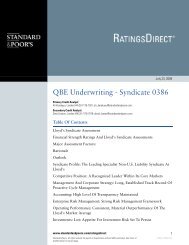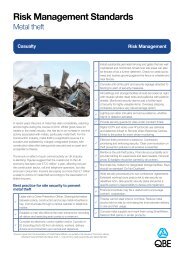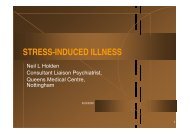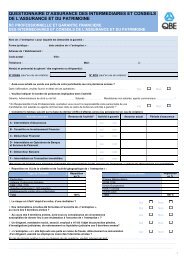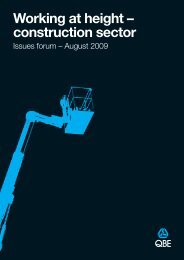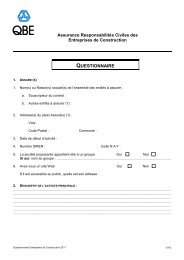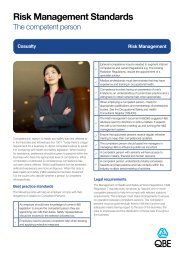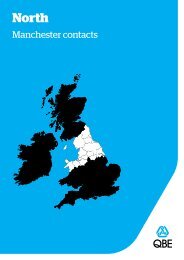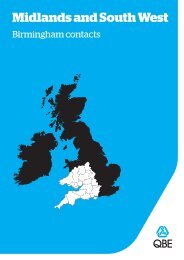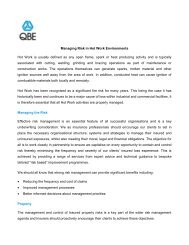QBE RM Standards, Permit to Work
QBE RM Standards, Permit to Work
QBE RM Standards, Permit to Work
You also want an ePaper? Increase the reach of your titles
YUMPU automatically turns print PDFs into web optimized ePapers that Google loves.
Risk Management <strong>Standards</strong><strong>Permit</strong> <strong>to</strong> workCasualtyRisk ManagementBest practice standardsBest practice guidance for permit <strong>to</strong> work systems:A permit <strong>to</strong> work system is a formal recorded process forcontrolling potentially hazardous work. It forms a means ofcommunication between those carrying out a job, supervisorsand site managers. A permit system has <strong>to</strong> have clearidentification of who can authorise hazardous work and whostipulates the safety measures, training and instruction on theissue, use and closure of permits. Moni<strong>to</strong>ring and auditing ofthe system will ensure it is used properly, with clear identificationof the hazardous work, permitted tasks and duration andthe specific control measures. The permit itself is a paperform or electronic certificate that communicates the relevantinformation <strong>to</strong> the parties concerned. The document authorisescertain people <strong>to</strong> carry out specific work at a specific place in aspecific timeframe and gives clear detail on the required safetyprecautions. <strong>Permit</strong> <strong>to</strong> work systems are used when the job couldaffect the safety of personnel, plant or the environment. The riskassessment process should identify the need for a permit system<strong>to</strong> be used. They are normally used for non-production work,non-routine operations, jobs where safety needs two parties <strong>to</strong>coordinate work and jobs where responsibilities transfer from oneperson <strong>to</strong> another. The permit alone does not guarantee safety, itis part of a system that requires different stakeholders <strong>to</strong> play theirpart and consider foreseeable risks and necessary precautions.Take all necessary steps before issuing a permit, e.g. riskassessment, instruction, isolation etc.Ensure there is proper authorisation <strong>to</strong> do the job by anauthorised person and that all persons sign <strong>to</strong> acknowledgetheir understanding of the permit and the controls <strong>to</strong> follow.Make clear the identity, nature, extent of the work andthe hazards involved. Specify limitations <strong>to</strong> the extent andtimescale of the work, any hazardous environments andthe required safety precautions.Ensure enough information is being included on the task aswell as necessary equipment and PPE.Identify those persons involved in the job and ensure theyhave the necessary resources.Ensure the person in charge of the workplace is aware ofthe hazardous work and its timescale.Record checks made by appropriate persons on the workand the precautions taken.Ensure that the permits are appropriately displayed andkept on file.Have a procedure for when work has <strong>to</strong> s<strong>to</strong>p before the jobis completed.Control other work activities which may impinge on thehazardous work being undertaken.Have a hand over procedure for when the job spans morethan one shift.Have a formal hand back procedure <strong>to</strong> ensure plant isreinstated in a safe condition.Use a change management process for when hazards arereassessed, for assessing the impact of change on otherprocesses and for effectively communicating change.Consult staff before implementing a permit <strong>to</strong> work system<strong>to</strong> maximize their buy in <strong>to</strong> the system.Ensure staff are suitably trained and instructed <strong>to</strong> use thesystem effectively.Consider human fac<strong>to</strong>rs such as stress and fatigue.
Legal requirementsThe use of permit <strong>to</strong> work systems is specifically required forhazardous tasks in the offshore sec<strong>to</strong>r by Regulation 10 of theOffshore Installations and Pipeline <strong>Work</strong>s (Management andAdministration) Regulations 1992. The guidance documentaccompanying the Electricity at <strong>Work</strong> Regulations 1989 alsosuggests permit systems for work on electrical equipment whilstit is dead. Otherwise, there is a long list of important piecesof legislation which require management systems <strong>to</strong> controlhazardous work, these include:--Confined Spaces Regulations 1997--Control of Major Accident Hazards Regulations 1999--Control of Substances Hazardous <strong>to</strong> HealthRegulations 2002--Dangerous Substances and Explosive AtmospheresRegulations 2002--Lifting Operations and Lifting Equipment Regulations1998--Provision and Use of <strong>Work</strong> Equipment Regulations1998.Guidance and useful information• HS(G)5 Hot <strong>Work</strong>: welding and cutting on plant containingflammable materials• OIAC Guidance on permit <strong>to</strong> work systems in the petroleumindustry, HSC, 1997• IND(G)98(Rev3) <strong>Permit</strong> <strong>to</strong> <strong>Work</strong> Systems, HSE 1997.Further informationFor more information please visit: www.<strong>QBE</strong>europe.com/rm oremail us on <strong>RM</strong>@uk.qbe.com<strong>QBE</strong> European OperationsPlantation Place30 Fenchurch StreetLondonEC3M 3BDtel +44 (0)20 7105 4000fax +44 (0)20 7105 4019enquiries@uk.qbe.comwww.<strong>QBE</strong>europe.comDisclaimerThis publication has been produced by <strong>QBE</strong> Insurance (Europe) Ltd (“QIEL”). QIEL is a company member of the <strong>QBE</strong>Insurance Group. Readership of this publication does not create an insurer-client, or other business or legal relationship.This publication provides information about the law <strong>to</strong> help you <strong>to</strong> understand and manage risk within your organisation. For fulldetails of the disclaimer surrounding this publication please visit http://www.qbeeurope.com/legal/publication-disclaimer.asp3379/<strong>QBE</strong><strong>RM</strong><strong>Standards</strong>/<strong>Permit</strong><strong>to</strong><strong>Work</strong>/Sept2012<strong>QBE</strong> European Operations is a trading name of <strong>QBE</strong> Insurance (Europe) Limited and <strong>QBE</strong> Underwriting Limited. <strong>QBE</strong> Insurance (Europe) Limited and <strong>QBE</strong>Underwriting Limited are authorised and regulated by the Financial Services Authority. <strong>QBE</strong> Management Services (UK) Limited and <strong>QBE</strong> Underwriting Services (UK)Limited are both Appointed Representatives of <strong>QBE</strong> Insurance (Europe) Limited and <strong>QBE</strong> Underwriting Limited.



